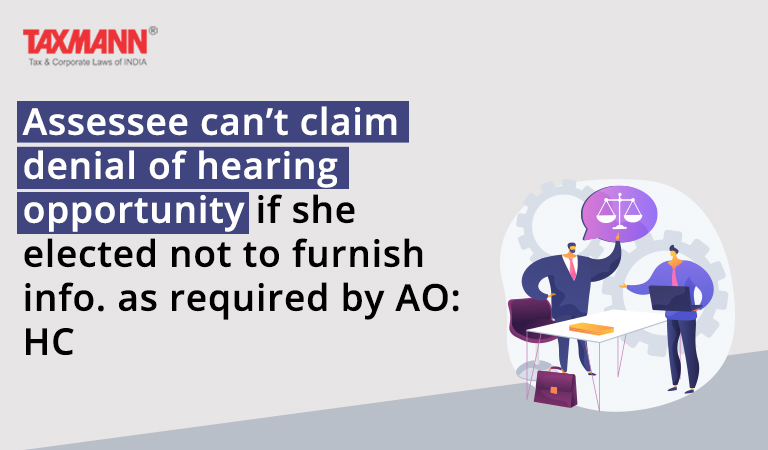Assessee can’t claim denial of hearing opportunity if she elected not to furnish info. as required by AO: HC
- News|Blog|Income Tax|
- 2 Min Read
- By Taxmann
- |
- Last Updated on 16 January, 2023

Case Details: Saroj Chandna v. ITO - [2023] 146 taxmann.com 30 (Delhi)
Judiciary and Counsel Details
-
- Manmohan & Ms Manmeet Pritam Singh Arora, JJ.
- C.S. Aggarwal, Sr. Adv., Ravi Pratap Mall, Uma Shankar & Mahir Aggarwal, Advs. for the Petitioner.
- Ruchir Bhatia, Sr. Standing Counsel & Ms Mansie Jain, Adv. for the Respondent.
Facts of the Case
The assessee was served with a reopening notice furnishing information and material relied upon by the Assessing Officer (AO). The assessee submitted response that the information and material provided in the notice did not pertain to her.
AO issued a second reopening notice with new information and asked for an explanation of a specific transaction, ultimately concluding it was an unreported amount and making an addition to the reassessment order.
The assessee filed a writ petition and argued that she was not given a fair hearing before the reassessment order was made and therefore it should be set aside.
High Court Held
The Delhi High Court held that to give effect to the objective of the scheme of section 148A, AO must provide specific material and information to the assessee at the stage of section 148A(b) so that the assessee can provide a meaningful response at the stage of inquiry under section 148A proceedings.
The argument that the assessee did not have the opportunity to respond to the allegations in the notice is not valid. Assessee chose not to provide any explanation or evidence for the transaction with Subhshree Financial Management Pvt. Ltd (SFML) as required by AO.
Since the assessee voluntarily chose not to furnish this information, she cannot claim that she was denied an opportunity to be heard. Thus, there was no error in the impugned order issued by the AO.
List of Cases Referred to
-
- Mon Mohan Kohli v. Asstt. CIT [2021] 133 taxmann.com 166/[2022] 441 ITR 207 (Delhi) (para 3)
- Union of India v. Ashish Agarwal [2022] 138 taxmann.com 64/289 Taxman 183/444 ITR 1 (SC) (para 4)
- Calcutta Discount Co. Ltd. v. ITO [1961] 41 ITR 191 (SC) (para 11)
- CIT v. Ms Mayawati [2011] 12 taxmann.com 306/201 Taxman 1/338 ITR 563/243 ITR 9 (Delhi) (para 11)
- CIT v. Bhaichand N. Gandhi [1982] 11 Taxman 59/[1983] 141 ITR 67 (Bom.) (para 11)
- Divya Capital One (P.) Ltd. v. Asstt. CIT [2022] 139 taxmann.com 461/445 ITR 436/2022 SCC Online Delhi 1461 (para 20).
Disclaimer: The content/information published on the website is only for general information of the user and shall not be construed as legal advice. While the Taxmann has exercised reasonable efforts to ensure the veracity of information/content published, Taxmann shall be under no liability in any manner whatsoever for incorrect information, if any.

Taxmann Publications has a dedicated in-house Research & Editorial Team. This team consists of a team of Chartered Accountants, Company Secretaries, and Lawyers. This team works under the guidance and supervision of editor-in-chief Mr Rakesh Bhargava.
The Research and Editorial Team is responsible for developing reliable and accurate content for the readers. The team follows the six-sigma approach to achieve the benchmark of zero error in its publications and research platforms. The team ensures that the following publication guidelines are thoroughly followed while developing the content:
- The statutory material is obtained only from the authorized and reliable sources
- All the latest developments in the judicial and legislative fields are covered
- Prepare the analytical write-ups on current, controversial, and important issues to help the readers to understand the concept and its implications
- Every content published by Taxmann is complete, accurate and lucid
- All evidence-based statements are supported with proper reference to Section, Circular No., Notification No. or citations
- The golden rules of grammar, style and consistency are thoroughly followed
- Font and size that’s easy to read and remain consistent across all imprint and digital publications are applied



 CA | CS | CMA
CA | CS | CMA
